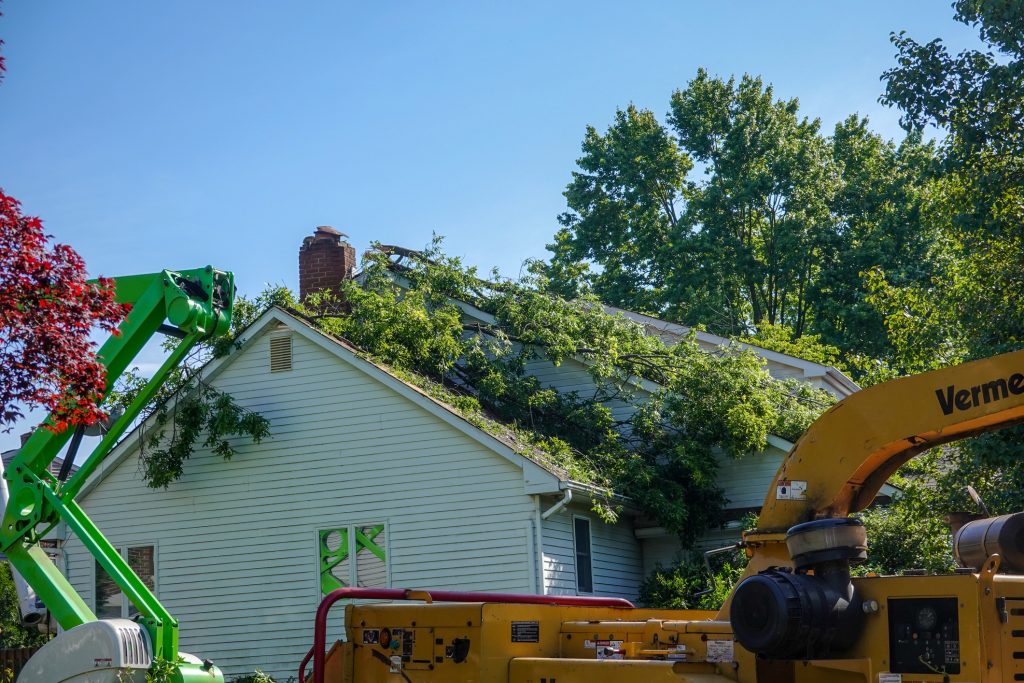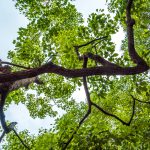The Hidden Dangers in Your Yard
Storm-related tree damage costs property owners in Georgia millions of dollars annually. Behind each of these incidents is a homeowner who likely went to bed thinking their majestic oaks and towering pines were perfectly healthy—until they weren’t.
Picture this: Dark clouds gather on the horizon. The wind picks up, howling through the trees surrounding your home. Rain begins to lash against your windows. You’ve weathered plenty of Georgia storms before, and your trees have always stood strong… but have you ever wondered what’s actually happening beneath the surface?
Most people assume a tree falls because of bad weather—but that’s only part of the story. The reality? Storms don’t typically cause trees to fall; they simply reveal weaknesses that have been developing for months or even years.
The #1 Reason Trees Fall During Storms: Compromised Root Systems
When we look at a tree, we’re only seeing half the story. Underground, a healthy tree maintains a root system typically extending 1.5 to 3 times the diameter of its canopy. These roots serve as both lifeline and anchor, providing stability against the forces of nature.
A compromised root system is the leading cause of tree failure during storms, yet it’s also the least visible to homeowners. Root systems can become compromised through several means:
- Soil erosion: Gradually washing away the supporting soil structure around roots
- Construction damage: Home renovations, driveway installations, or utility work that cuts through critical roots
- Overwatering: Creating soggy conditions that lead to root rot
- Poor soil conditions: Compacted soil prevents proper root expansion and oxygen intake
- Root diseases: Fungal infections that decay roots from the inside out
The most dangerous aspect of root problems is their invisibility. While dead branches or leaf discoloration might alert you to issues above ground, root damage progresses silently until that fateful storm brings the consequences crashing down—often onto roofs, vehicles, or power lines.
Other Common (But Less Talked About) Risk Factors
While compromised root systems top the list of reasons trees fall during storms, several other factors significantly increase risk:
Internal Decay or Hollow Trunks
Trees can appear perfectly healthy on the outside while harboring extensive internal decay. This condition, often caused by fungi or bacteria entering through wounds, can hollow out the structural core of a tree. A healthy tree can withstand losing 30-40% of its interior wood, but beyond that threshold, structural integrity becomes compromised.
Signs of internal decay might include:
- Mushrooms or conks growing on the trunk
- Cavities or hollow-sounding areas when tapped
- Carpenter ant activity
- “Weeping” areas where sap leaks out
Leaning Trees
While some trees naturally grow at an angle, a sudden lean often indicates shifting roots or unstable soil. Trees that have always leaned slightly can live their full lifespan without issue, but a tree that has recently begun leaning more than 15 degrees from vertical warrants immediate professional assessment.
Weak Branch Unions
Not all branches attach to trees with equal strength. V-shaped unions (where branches meet the trunk at sharp angles) are inherently weaker than U-shaped unions. These weak attachment points become failure zones during high winds or under the weight of ice and snow.
Overgrown Canopies
An excessively dense canopy acts like a sail in strong winds. Trees that haven’t been properly pruned capture more wind force, which creates greater stress on both the trunk and root system. Many homeowners avoid pruning mature trees, inadvertently increasing their likelihood of storm damage.
Signs Your Tree Might Be at Risk
While root issues may be hidden, there are warning signs that indicate potential problems:
- Soil heaving around the base: Raised or cracked soil near the trunk often indicates root movement.
- Mushrooms or fungus growth: Especially near the base of the tree or major roots, fungal bodies suggest internal decay.
- Cracks in the trunk or major limbs: These structural weaknesses can rapidly worsen during storms.
- Sudden leaning after heavy rain: This suggests root failure has already begun.
- Sparse leaves or early leaf drop: While these could indicate various health issues, they often reflect root stress.
- Multiple dead branches: More than 25% deadwood in the canopy suggests systemic health problems.
- Recent construction: Any major digging, grading, or building within the tree’s root zone (typically the area under the canopy plus 50%) increases failure risk.
How to Prevent Tree Failures During Storms
Fortunately, many tree failures are preventable with proper care and regular maintenance:
Regular Inspections
Twice-yearly inspections—ideally in early spring before leaf growth and in fall before winter storms—can identify potential problems before they become critical. After any severe weather event, perform a quick visual assessment of your trees for new damage.
Professional arborists have specialized tools to detect internal decay, root health issues, and structural weaknesses that aren’t visible to untrained eyes. For valuable mature trees or those near structures, professional assessment is a wise investment.
Proper Pruning Techniques
Strategic pruning reduces both weight and wind resistance. However, improper pruning can create entry points for disease or cause structural imbalance. Proper techniques include:
- Removing dead, diseased, or broken branches
- Thinning the canopy to reduce wind resistance
- Eliminating crossing or rubbing branches
- Maintaining the tree’s natural shape
Avoid “topping” trees (removing large sections of the crown), as this harmful practice leads to weak regrowth and increases decay.
Cabling and Bracing
For valuable trees with structural weaknesses, professional cabling or bracing can provide supplemental support. These systems redistribute weight and provide additional stability during high winds, potentially adding decades to a tree’s safe lifespan.
Mulching and Proper Watering
Healthy roots begin with healthy soil. A 2-4 inch layer of mulch (kept away from direct contact with the trunk) can:
- Regulate soil temperature
- Retain moisture
- Prevent lawn equipment damage
- Reduce soil compaction
- Provide nutrients as it decomposes
During extended droughts, deep, infrequent watering encourages roots to grow downward, creating more stable anchoring.
Protecting the Root Zone
The most critical preventive measure is protecting the root zone from damage:
- Avoid compacting soil over roots with heavy equipment or excessive foot traffic
- Don’t change the grade (soil level) around existing trees
- Keep construction activities well away from the root zone
- Avoid trenching through root areas for utilities or irrigation
- Don’t pave or build structures over major roots
When to Call in a Professional
While regular homeowner observation is valuable, certain situations demand professional expertise:
- Trees showing multiple risk factors
- Large dead branches over structures or high-traffic areas
- Visibly damaged or decayed areas on major limbs or trunks
- Recent leaning or soil heaving
- Trees larger than 15-20 feet that require assessment or pruning
- Any concerns about a tree’s structural stability
Remember: Professional tree removal is an investment in safety. Amateur tree work ranks among the most dangerous DIY activities, resulting in numerous injuries and fatalities each year.
Final Thoughts
The real threat to your trees isn’t the storm itself—it’s the pre-existing weaknesses the storm exposes. By understanding that compromised root systems and other hidden issues are the true culprits behind most tree failures, you can take appropriate preventive action.
Proactive tree care not only protects your property from damage but also preserves the beauty, shade, and value that mature trees provide. The cost of preventive maintenance is invariably less than emergency removal and property repairs after a failure.
Ready to Protect Your Property?
Concerned about a tree on your property? Don’t wait for the next storm to find out it’s unstable. Schedule a professional tree assessment today to protect your home, your property, and your peace of mind.
Call VMG Tree Care at 404-456-6794 or request a free estimate online. Our ISA Certified Arborists serve Marietta and the greater Atlanta region with expert tree assessments, maintenance, and when necessary, safe removal.
VMG Tree Care has been serving the North Georgia region since 1989 with professional tree services for both residential and commercial properties. We’re fully licensed, insured, and dedicated to preserving the health and safety of your trees.


